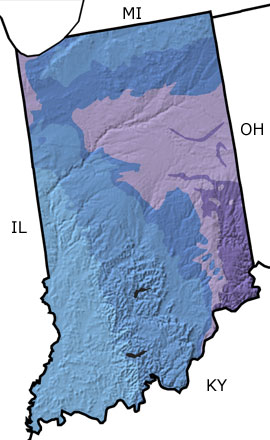Paleontology and geology The Precambrian: The Precambrian in Indiana is represented primarily by igneous rocks, thus there are no Precambrian fossils known from the state. These igneous rocks are not exposed at the surface anywhere in the state and are known only from drill cores.
The Paleozoic: The Paleozoic is well represented in Indiana by both sedimentary rocks and fossils. Earliest Paleozoic (Cambrian) rocks are present only in the subsurface, but fossil trilobites indicate that a shallow sea covered the state at this time. Indiana lay near the equator for much of the Paleozoic, and the warm, shallow, limy sea that existed from the Ordovician through the Devonian was home to abundant marine life. Conditions changed later in the Paleozoic as fine black and gray muds eroding off the distant Acadian mountains washed into the shallow sea. By the Carboniferous, rivers delivered large amounts of sand to the sea and onto deltas. Crinoids, bryozoans, brachiopods, gastropods, bivalves, and trace fossils are common in the Late Paleozoic marine rocks of Indiana. Plant material accumulated on the deltas and became the source of Indiana’s abundant coal deposits.
The Mesozoic:There are no Mesozoic rocks exposed or present in the subsurface in Indiana. This was primarily a time when the state stood above sea level and sediments would have been deposited only in limited areas, such as in streams or lake beds. Any rocks that might have formed from these sediments were later removed by erosion.
The Cenozoic: Early Cenozoic (Tertiary) rocks are present only in scattered locations and are buried under Quaternary glacial deposits. Some information about life in the state at this time has been provided by the fossils of vertebrates, invertebrates, and plants that were recovered from a sinkhole. The Late Cenozoic (Quaternary) was a time of advancing and retreating glaciers, which scoured the landscape of northern Indiana nearly flat. During this glacial period, mammals such as mastodons, mammoths, giant short-faced bears, and the stag moose roamed the state. |

